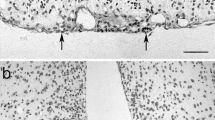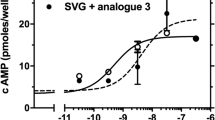Abstract
Recent studies have demonstrated the occurrence of endocannabinoids and their CB1 receptor subtype in the anterior pituitary gland, despite previous evidence suggesting their exclusive presence and action in the neuroendocrine hypothalamus. The present study was designed to examine the potential changes in these CB1 receptors located in the anterior pituitary gland in three different experimental situations, which are known to affect anterior pituitary function: (i) estrogen-induced pituitary tumorization, (ii) presence of ectopic pituitaries, and (iii) chronic treatment with D1 or D2 dopaminergic receptor agonists or antagonists. Results were as follows. Induction of pituitary tumorization by implantation of silastic capsules containing diethylstilbestrol, a synthetic estrogen, produced the expected body weight loss and increase in pituitary weight and plasma prolactin (PRL) levels. In hyperplastic pituitaries, both CB1 receptor mRNA levels and immunoreactivity decreased significantly. Double labelling studies demonstrated that CB1 receptors colocalized, in pituitary tumors, with PRL- or luteinizing hormone-containing cells, as they did in normal pituitaries. Plasma PRL levels were also increased in rats bearing ectopic pituitaries implanted under the kidney capsule. As previously reported, this increase was originated by the hormone release from the ectopic gland, because the normotopic pituitary collaborated scarcely to elevate PRL levels since it was hypofunctional due to the activation of peripheral PRL-induced feedback mechanisms. However, in this hypofunctional anterior pituitary, there were not any changes in CB1 receptor mRNA levels and immunoreactivity. Finally, chronic treatment with SKF38393, a D1 receptor agonist, or bromocriptine, a D2 receptor agonist, or with their corresponding antagonists, SCH 23390 or sulpiride, respectively, did not alter CB1 receptor mRNA levels and immunoreactivity, although produced the expected changes in plasma PRL levels. In summary, estrogen-induced pituitary tumorization was associated with a marked reduction in CB1 receptors, despite the fact that these receptors were located, among others, on lactotroph cells which develop hyperplasia during tumor induction. Whether this decrease is associated with the ethiology of pituitary tumor induction and whether their pharmacological activation might affect tumorization process are presently unknown, but this will be subjected of further research.
Similar content being viewed by others
References
Murphy LL, Steger RW, Bartke A. Psychoactive and nonpsychoactive cannabinoids and their effects on reproductive neuroendocrine parameters. In: Watson RR, Ed., Biochemistry and Physiology of Substance Abuse, vol 2. CRC Press, Boca Raton, FL, 1990:73.
Jackson AL, Murphy LL. Role of the hypothalamic-pituitary-adrenal axis in the suppression of luteinizing hormone release by Δ9-tetrahydrocannabinol. Neuroendocrinology 1997;65:446.
Fernández-Ruiz JJ, Muñoz RM, Romero J, Villanua MA, Makriyannis A, Ramos JA. Time course of the effects of different cannabimimetics on prolactin and gonadotrophin secretion: Evidence for the presence of CB1 receptors in hypothalamic structures and their involvement in the effects of cannabimimetics. Biochem Pharmacol 1997;53:1919.
Romero J, García-Gil L, Ramos JA, Fernández-Ruiz JJ. The putative cannabinoid receptor ligand, anandamide, stimulates tyrosine hydroxylase activity and inhibits prolactin release. Neuroend Lett 1994;16:159.
Wenger T, Fragakis G, Probonas K, Toth BE, Yiannakakis N. Anandamide (endogenous cannabinoid) affects anterior pituitary hormone secretion in adult male rats. Neuroend Lett 1994;16:295.
Wenger T, Jamali KA, Juaneda C, Leonardelli J, Tramu G. Arachidonyl ethanolamide (anandamide) activates the parvocellular part of hypothalamic paraventricular nucleus. Biochem Biophys Res Comm 1997;237:724.
Weidenfeld J, Feldman S, Mechoulam R. Effect of the brain constituent anandamide, a cannabinoid receptor agonist, on the hypothalamo-pituitary-adrenal axis in the rat. Neuroendocrinology 1994;59:110.
Romero J, Wenger T, De Miguel R, Ramos JA, Fernández-Ruiz JJ. Cannabinoid receptor binding did not vary in several hypothalamic nuclei after hypothalamic deafferentation. Life Sci 1998;63:351.
Murphy LL, Chandrashekar V, Bartke A. ?9-Tetrahydrocannabinol inhibits luteinizing hormone secretion in the male rat: Effect of intracerebroventricular norepinephrine infusion. Neuroend Lett 1994;16:1.
De Miguel R, Romero J, Muñoz RM, García-Gil L, González S, Villanua MA, Makriyannis A, Ramos JA, Fernández-Ruiz JJ. Effects of cannabinoids on prolactin and gonadotrophin secretion: Involvement of changes in hypothalamic ?-aminobutyric acid (GABA) inputs. Biochem Pharmacol 1998; 56:1331.
Kramer J, Ben-David M. Prolactin suppression by (-)-Δ9-tetrahydrocannabinol (THC): Involvement of serotoninergic and dopaminergic pathways. Endocrinology 1978;103:452.
Hughes CL, Everett JW, Tyrey L. ?9-Tetrahydrocannabinol suppression of prolactin secretion in the rat: Lack of direct pituitary effect. Endocrinology 1981;109:876.
González S, Manzanares J, Berrendero F, Wenger T, Corchero J, Bisogno T, Romero J, Fuentes JA, Di Marzo V, Ramos JA, Fernández-Ruiz JJ. Identification of endocannabinoids and cannabinoid CB1 receptor mRNA in the pituitary gland. Neuroendocrinology 1999;70:137.
Wenger T, Fernández-Ruiz JJ, Ramos JA. Immunocytochemical demonstration of CB1 cannabinoid receptors in the anterior lobe of the pituitary gland. J Neuroend 1999;11:873.
Wenger T, Jamali KA, Juaneda C, Bacsy E, Tramu G. The endogenous cannabinoid, anandamide, regulates anterior pituitary secretion in vitro. Addict Biol 2000;5:59.
Herkenham M, Lynn AB, Johnson MR, Melvin LS, De Costa BR, Rice KC. Characterization and localization of cannabinoid receptors in rat brain: A quantitative in vitro autoradiographic study. J Neurosci 1991;11:563.
Lynn AB, Herkenham M. Localization of cannabinoid receptors and non-saturable high-density cannabinoid binding sites in peripheral tissues of the rat: Implications for receptor-mediated immune modulation by cannabinoids. J Pharmacol Exp Ther 1994;268:1612.
Murphy LL, Newton SC, Dhali J, Chavez D. Evidence for a direct anterior pituitary site of Δ9-tetrahydrocannabinol action. Pharmacol Biochem Behav 1991;40:603.
Rodríguez de Fonseca F, Wenger T, Navarro M, Murphy LL. Effects of ?9-THC on VIP-induced prolactin secretion in anterior pituitary cultures: Evidence for the presence of functional cannabinoid CB1 receptors in pituitary cells. Brain Res 1999;841:114.
Genazzani AR, Lucchesi A, Stomati M, Catarsi S, Genazzani AD, Criscuolo M, Petraglia F. Effects of sex steroid hormones on the neuroendocrine system. Eur J Contracept Reprod Health Care 1997;2:63.
González S, Bisogno T, Wenger T, Manzanares J, Milone A, Berrendero F, Di Marzo V, Ramos JA, Fernández-Ruiz JJ. Sex steroid influence on cannabinoid CB1 receptor mRNA and endocannabinoid levels in the anterior pituitary gland. Biochem Biophys Res Comm 2000;270:260.
Di Marzo V, Melck D, De Petrocellis L, Bisogno T. Cannabimimetic fatty acid derivatives in cancer and inflammation. Prostag Lipid Mediat 2000;61:43.
Tsou K, Brown S, Sañudo-Pena C, Mackie K, Walker JM. Immunohistochemical distribution of cannabinoid CB1 receptors in the rat central nervous system. Neuroscience 1998;83:393.
Fernández-Ruiz JJ, Cebeira M, Rodríguez F, Ramos JA. Effects of dopamine on prolactin release from ectopic and hyperplastic anterior pituitaries: changes at receptor and postreceptor level. Neuroend Lett 1990;12:455.
Rubino T, Massi P, Patrini G, Venier I, Giagnoni G, Parolaro D. Chronic CP-55,940 alters cannabinoid receptor-mRNA in the rat brain: an in situ hybridization study. Neuroreport 1994;5:2493.
Battaglia AA, Feuilloley M, Mulatero B, Beltramo M, Thibault J, Franzoni M F, Calas A, Vaudry H, Fasolo A. Confocal microscopy analysis of NPY and TH immunoreactivities in the hypothalamo-hypophysial system of the frog. Neuroreport 1995;6:645.
Freeman ME, Kanyicska B, Lerant A, Nagy G. Prolactin: structure, function and regulation of secretion. Physiol Rev 2000;80:1523.
Author information
Authors and Affiliations
Rights and permissions
About this article
Cite this article
González, S., Romanazzi, M., Berrendero, F. et al. Decreased Cannabinoid CB1 Receptor mRNA Levels and Immunoreactivity in Pituitary Tumors Induced by Prolonged Exposure to Estrogens. Pituitary 3, 221–227 (2000). https://doi.org/10.1023/A:1012874029689
Issue Date:
DOI: https://doi.org/10.1023/A:1012874029689




